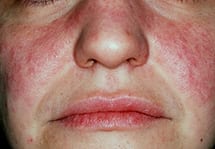Lupus – (Systemic Lupus Erythematosus, SLE)
Serving Hamilton, Stoney Creek, Grimsby and surrounding areas
Diagnosis:
- Lupus is diagnosed based on several symptoms and signs being present in the same patient, which include:
- Facial rash (butterfly rash)
- Specific skin spots (discoid lesions)
- Skin biopsy
- Blood tests. (e.g. ANA, Anti-DNA, ENA)
- Arthritis
- Kidney problems
- Blood problems (e.g. low white count)
- Chronic sores in the mouth (canker sores)
- Sensitivity to the sun
- The facial rash of lupus is not the same as rosacea
- In rosacea, patients often get pimples, which are not associated with lupus
- Just because a person has one of these signs does not mean that he or she has lupus
- Several of these must be present to make a diagnosis
- If you are concerned that you may have lupus, please see your doctor
Treatment
Sun Protection:
- Sun exposure clearly causes lupus to flare or worsen
- Wear a hat with a broad brim and protective clothing (e.g. long sleeves)
- Avoid the outdoors when the sun is strongest between the hours of 10 am to 3 pm
- Wear a sunscreen which resists water and sweating and which protects against both UVA and UVB
- Reapply sunscreen every hour if you are in water or sweating heavily
- Wear sunscreen even if you are in the shade, it is still possible to burn
- Avoid tanning beds
- The ultraviolet light from tanning beds causes skin cancer and may cause lupus to flare
Topical Corticosteroids (Steroids, Cortisone):
- Cortisone creams (topical corticosteroids), lotions and gels are moderately effective
- They are used twice daily on the affected areas until the spots disappear or turn brown
- At that point the steroids should be stopped
- They are used twice daily on the affected areas until the spots disappear or turn brown
- Topical corticosteroids must be used for at least a month to see if they are going to be effective
- The most common side effect would include, but not be limited to: thinning of the skin in the area to which they are being applied
- This may appear as stretch marks, dimpling of the skin or bruising
Intralesional Kenalog (Cortisone Injections):
- Cortisone injections work much better than the creams, gels and lotions
- Injections are primarily use when people suffer from “discoid” lesions on the skin.
- The cortisone is injected directly into the affected areas
- A lesion 5 cm (2 inches) in diameter would require about 8 injections
- The injections are repeated at monthly intervals
- The main side effect from the injections includes, but is not limited to: thinning of the skin
- This may appear as stretch marks, dimpling of the skin or bruising
- Skin thinning will usually resolve spontaneously once treatment is stopped
Pills:
- A variety of pills are available
- Please discuss your treatment options with your doctor
SLE – Malar Rash
Lupus – Butterfly Rash
What if you are interested to learn more?
If you would like to learn more please phone the aesthetic centre directly at (905) 549-7873 to book a free consultation with one of our knowledgeable technicians or


